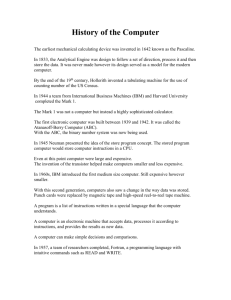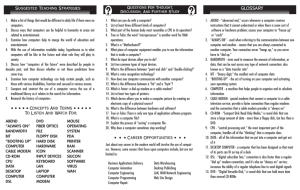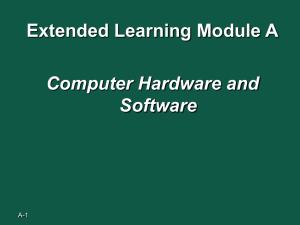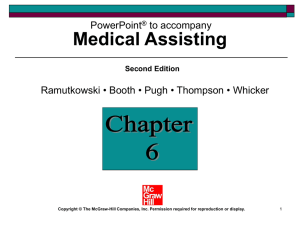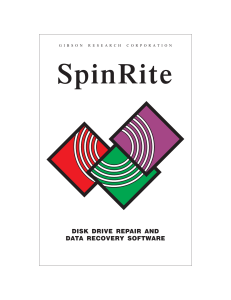Understanding Computers Today and Tomorrow
advertisement
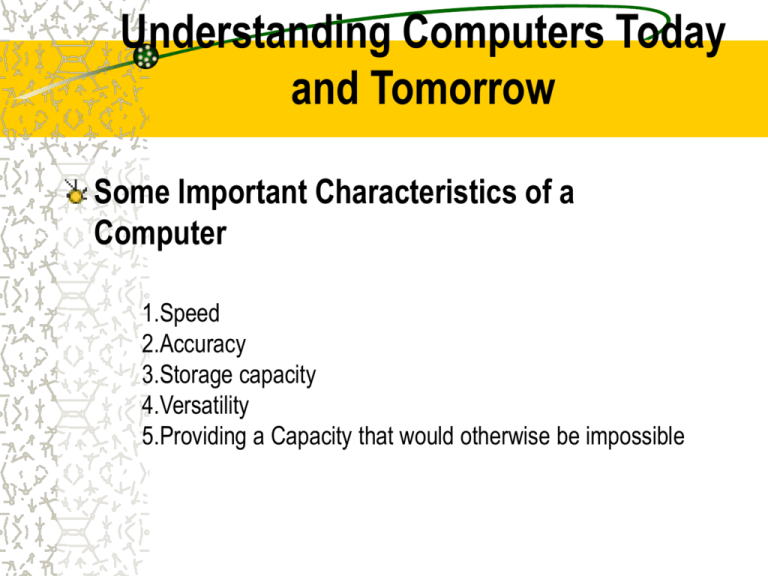
Understanding Computers Today and Tomorrow Some Important Characteristics of a Computer 1.Speed 2.Accuracy 3.Storage capacity 4.Versatility 5.Providing a Capacity that would otherwise be impossible Hardware and Software Hardware - The physical parts of the computer that you can see and touch Software - Computer programs Program -- a list of instructions to be performed by a computer Data -- a collection of raw, unorganized facts Information -- data that have been processed into a meaning form Computer Hardware Computer hardware typically is divided into four categories. They are input devices, processing unit, output devices, and storage media (harddisk drive, diskette drive, or CD drive) Input and output devices are also referred to as peripheral devices. Central Processing Unit (CPU)--It is made up of the Arithmetic/Logic unit, Control unit, and Primary memory. Types of Computers a. b. c. d. Small (Microcomputers or Personal Computers) $500 - $7,000 Desktop Computers and Workstations Laptop Computers Notebook Computers Palmtop Computers Computers Medium-sized computers (minicomputers) $50,000 - $200,000 3 - 25 times faster than a PC Large or Mainframe Computers $100,000 - $2,000,000 10 - 100 times faster than a PC Superlarge or Supercomputers $2 million - $20 million 50 - 50,000 times faster than a PC HW1 The Central Processing Unit and Memory Digital Computers -- a device that counts. Analog Computers -- a device that measure. •CPU -- A collection of electronic circuits. CPU consists of ALU and Control Unit. •ALU -- Arithmetic/logic unit •Control Unit -- control overall operations of the system. Memory (Main Memory, Primary Memory, RAM) RAM (Random Access Memory) is a set of storage locations on the main circuit board. It is a temporary storage for data, programs and the operating system while you are using the PC. It is volatile, meaning that the contents of memory are lost forever when the computer is shut off. ROM (Read-only memory) consists of non-erasable hardware modules that store program instructions. It is nonvolatile Computer Processing Speed and Storage Terminology Microsecond - one millionth of a second Nanosecond - One billionth of a second Picosecond - one trillionth of a second Clock speed - MHz (megahertz) one million clock ticks per second Bit (Binary Digit) - The smallest unit of computer memory -- 0 or 1. Byte - Eight adjacent bits that represents a single character of data. Computer Processing Speed and Storage Terminology Kilobyte (K or KB) - 1024 bytes (1024 characters) Megabyte (M or MB) - 1024K (Approximately equal to one million bytes) Gigabyte (G or GB) - 1024M (Approximately equal to one billion bytes) ASCII and EBCDIC (page HW12) Machine language -- 0100100001001001 HW 2 -- Secondary Storage Secondary Storage Hardware includes devices that permanently store data and programs (nonvolatile) Magnetic Disk Hard disk (fixed disk) Most PC hard disks have capacities in the range of 1GB to 2.5GB. Diskette (soft disk, floppy disk) 5.25-inch diskette 3.5-inch diskette DS/DD - 720 K storage capacity DS/HD - 1.44 MB Secondary Storage Magnetic Tape -- A plastic ribbon with a magnetizable surface that stores data as a series of magnetic spots. Optical Disk -- A disk read by reflecting pulses of laser beams. CD-ROM -- Storage capacities begin at 128 MB and can exceed 1GB HW3 Input and Output Input Hardware (Input Devices) Equipment that supplies data and programs to the computer Keyboards Pointing devices -- Mouse, light pen, joystick etc. Voice-Input systems -- A system that enables a computer to recognize the human voice. Input Hardware Source data automation: page HW 89~95 The process of collecting data at their point of origin in digital form. 1. OCR (Optical Character Recognition) The use of reflected light to input marks, characters, or codes. 2. MICR - Banking industry technology that processes checks by sensing special characters inscribed in a magnetic ink. 3. Digital Cameras Output Hardware (Output Devices) Equipment that accepts data and programs from the computer Display devices: An output device that contains a viewing screen. Monitor CRT (Cathode Ray Tube): CRT is a TV-like video screen used by most desktop computers Output Hardware (Output Devices) Printers: A device that records computer output on paper. Impact printing: A technology that forms characters by striking a pin or hammer against an inked ribbon, which presses the desired shape onto paper. Ex.: Dot-matrix printer Nonimpact printing: A technology that forms characters and other images on a surface by means of heat, lasers, photography, or ink jets. Ex: Ink-jet printers, Laser printers Output Hardware (Output Devices) Other output equipment Speakers provide audio output. Plotters provide charts, drawings, maps, and three dimensional illustration SW1 SOFTWARE 1. System software - Computer programs, such as the operating system, that enable applications programs to work with a computer system’s hardware. 2. Application software - Programs that provide tools for performing the type of work that people buy computer system to do. Windows Windows - a box of related information that appears overlaid on a display screen. (SW 20) 1. Cascading versus Tiling Windows 2. Resizing and Moving Windows 3. Maximizing versus Minimizing Windows Communications Hardware Modem (Modulator/Demodulator) Modem is a communications device that allows computers to exchange data over telephone lines. Modulator - translates computer's digital signals to telephone's analog signals. Demodulator - translates telephone's analog signals to computer's digital signals. Communication Baud Rate - the speed of data transmission measured in bps (bits per second). Examples: 10 pages letter is transmitted by 2400 baud rate modem in 2.5 min., 9600 modem in 38 seconds. Communication Software - manages transmission of data Examples: Kermit, SmartCom, ProComm, etc. Access to online service - America Online, CompuServe, Prodigy, etc.
